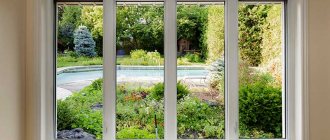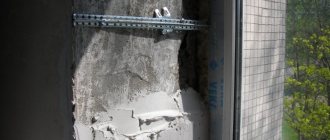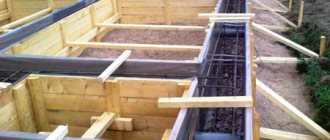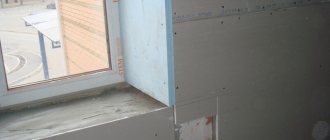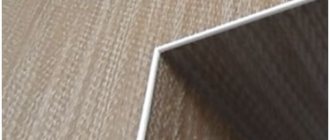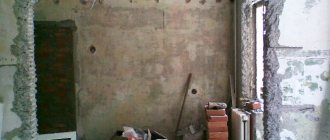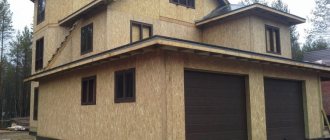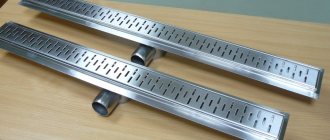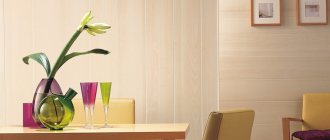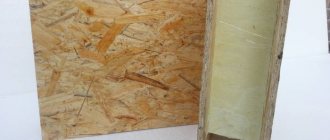The final stage of the process of installing modern windows is finishing the slopes. A thick profile, multi-chamber double-glazed windows and reliable fittings provide excellent thermal insulation, but the interface between the window frame and the apartment wall remains a cold and unattractive place. If this area is not given proper attention, condensation, mold, and wall destruction may occur. Therefore, let's find out which slopes are best suited for plastic windows.
What requirements must slopes meet?
Before considering window framing options, their advantages and disadvantages, let’s determine what is required of these elements.
Expert opinion
Anton Tsugunov
Construction expert. Entrepreneur. 17 years of experience. More than 100 completed objects.
Hello, friends!
First, I will talk about all types of slopes, as well as their pros and cons. I will describe the subtleties and share my experience. At the end of the article I will give recommendations on which slopes are the best choice, and in which cases one should give preference to one or another material and finishing method.
Enjoy reading!
Slopes should:
- Not inferior to the durability of the window design. Modern double-glazed windows are designed for a minimum of 15–20 years of operation. Slopes must withstand no less time without loss of basic qualities. Few people would like to redo them every two or three years.
- Comply with the general style of the window, forming a single whole with it.
- Maintain or even improve the performance characteristics of plastic windows.
- Withstand mechanical loads and impacts of the doors.
- If possible, be repairable.
Purpose of external slopes
The coating inside the window opening, which protects the window profile from environmental influences, is called a slope. Conventionally, according to location, it is customary to distinguish external and internal slopes. Although they are parts of the window opening, each has its own function.
The main functions of external slopes include:
- giving the glass unit an attractive appearance. A high-quality window structure should not be adjacent to a broken wall;
- increasing the level of thermal and sound insulation. Without high-quality slopes, it is impossible to create the necessary tightness of double-glazed windows, which means that the room will not be protected from the street;
- protection of the window frame from environmental influences. A well-equipped slope protects the mounting elements of the structure from corrosion; in addition, the possibility of freezing and fogging of the glass unit is reduced. In any case, a protected window frame lasts longer, which means it does not need to be repaired or replaced frequently.
When installing plastic windows, installers rarely finish the outer slopes at the same time. This work is significantly more expensive than installation and is performed separately.
The sun destroys the foam
Advice!
It is better not to put off finishing the external slopes for too long. Firstly, unprotected polyurethane foam has no strength, and secondly, it will have a bad effect on the condition of the window frame.
Plaster slopes
The manufacturing technology consists of installing beacons, plaster corners and applying plaster. After drying, the slopes are puttied, sanded and painted. It is extremely difficult to do high-quality insulation, since the connection between the solution and the wall is lost.
Finishing a window opening with plaster has the following advantages:
- Versatility. This material is used in rooms with different humidity and temperature levels.
- Reasonable price. Plaster is an inexpensive material, and you can also save money by doing the work yourself.
- Strength. Plaster slopes are more resistant to mechanical stress compared to other types of finishing.
- No seams. Perhaps the main argument of supporters of such a coating is that there is no need to additionally process the joints and interfaces of the opening planes.
- Possibility of updating and repair.
USEFUL INFORMATION: Plastering window slopes with your own hands
But a number of serious shortcomings have led to the fact that plaster is used less and less for work of this kind:
- Duration and complexity of the process. Finishing takes considerable time: each layer of the plaster mixture needs to dry.
- A large amount of dust and dirt, risk of scratching the window.
- Low thermal insulation properties of plaster. Such slopes are prone to freezing in winter and condensation. In addition, when installing them, you have to cut the foam one or two centimeters inward, weakening the thermal insulation seam.
- Detachment from frame. It is impossible to firmly connect the plaster and the PVC frame. There are no sealants with equally good adhesion to both materials. This leads to the formation of cracks between the window block and the plaster layer.
USEFUL INFORMATION: Adjacent profile for window slopes
The last two drawbacks can be eliminated by insulating the opening with penoplex before plastering and using an adjacent window profile with reinforcing mesh.
USEFUL INFORMATION: How to putty the slopes on windows?
Expert opinion
Anton Tsugunov
Construction expert. Entrepreneur. 17 years of experience. More than 100 completed objects.
Today this is the dirtiest and longest finishing method. To avoid problems with condensation and mold, I recommend choosing this method only in warm rooms, for example, when a window is installed between a heated balcony and a living room, then freezing of the slopes is excluded. And also if there is simply no room left to install sheet material. For plastering warm slopes, I have been using Rotband plaster from Knauf . I buy it only from a trusted supplier. I order from the Leroy online store and pay by card. Here is the link >>>
This is better than going to the store, standing in lines first at the checkout, and then at checkout. The mixture is delivered to me directly to the site at the agreed time. It’s more convenient and safer!
Without starting profile
This method of installing window slopes can be used when the distance from the window frame to the wall is too small. Installation with a starting profile in this case is either very complicated or completely impossible. The arrangement of slopes of plastic windows begins with preparing the opening. In this case, the foam fragments are cut off with a stationery knife. It doesn't take too much effort to remove it.
The polyurethane foam should not be cut, it should be removed evenly. In this case, it will cope with its function of fixing the frame. It will also insulate it, preventing drafts from the street. It is also necessary to remove pieces of plaster that interfere with work and protrude, giving the window opening an unattractive appearance. If they hold up well, you can leave them alone. The foam will slide off less.
Along the perimeter of the window, a thin 10 by 40 mm strip is nailed with the wide side to the slope. Usually it is nailed as is, but it can be leveled by placing thin planks and pieces of plywood in the necessary places. Following this, the foam is cut around the perimeter of the frame so that the sandwich panels fit here. It should go 1 cm.
The foam must be cut carefully so that the plastic does not get damaged. After this, they begin processing the plastic panels. You can do the standard thing by making a stencil after all the necessary measurements. To do this, take a sheet of paper. It should be larger in size than the window slope. They apply it to it, crimp it, remove the excess. The paper is cut along the curved edges, tried on, and adjustments are made as necessary. The top part of the frame is the easiest place to start.
After forming the paper stencil, outline it on the plastic. Approximately 1 cm will go into the foam groove. It is necessary to cut with a small margin, since cutting will be easier than covering it up later. Using a hacksaw, they try on the plastic and make adjustments so that it stands up straight, without bending. Align so that the panel is flush with the plaster. The edges turn out to be almost even; where necessary, some finishing is done with a file.
After removing the strip of material along the outer edge, which will be nailed to the plank, drill a hole according to the thickness of the nails, retreating 6 cm from the edge. This will make it easier to secure the plastic without causing damage to it. The slope is then put back into place. Take a balloon with polyurethane foam and little by little fill the entire gap with foam. We must try to get as deep as possible, but a large consumption of material is undesirable. Foam can spill and damage the plastic.
Working with polyurethane foam
If there is smooth plastic, the foam provides good adhesion to it. If you have to treat the surface directed towards the wall, it is necessary to use a primer or sand it for improved adhesion. Another nuance is that moisture is necessary for optimal polymerization of the foam. That is why before installing the plastic, the slope must be sprayed with water from a spray bottle. There should be no dust on the wall. It is cleaned with a brush or removed with a vacuum cleaner. If the solution is loose, treat the opening with a penetrating primer in advance. It carries the function of binding concrete particles together.
Subsequently, the panel rises. Nails are inserted into the hole and the outer edge is secured in the strip. The internal surfaces are fixed, resting against the window frame.
The work is carried out according to the same algorithm:
- cut out a paper template and try it on;
- transfers it to plastic, cutting out the side of the plastic;
- process the edges with sandpaper so that there is a minimum of space between the upper slope and the panel.
Next steps include:
- Adjusting the parts until they match perfectly at the bottom and top.
- Installing elements in place. In this case, one edge is driven into the groove near the window.
- Drilling holes for nails along the outer edge.
- Installing the panels in place.
- Filling gaps with foam from bottom to top. This should be done in small portions to penetrate as much space as possible.
Working on the vertical parts of slopes requires a slightly different approach. Foam is applied here before parts are installed. The panel located along the far edge is processed if it is ready for installation. She is brought under the frame. The foam strip should be applied in a thin stream, stepping back slightly from the edge. After inserting the plastic part, the cut groove is filled with the rest of the foam gap. Before doing this, be sure to wet the wall. After this, the slope is pressed, leveled and secured in the plank with nails.
To prevent the foam from moving the edges of the slope during polymerization, the joints in the lower and upper parts are taped with masking tape. But even if all manipulations are performed perfectly, small gaps will remain. They are covered with acrylic. It is sold in tubes similar to packaging with polyurethane foam. The product is applied in the same way, through a mounting gun.
Drywall slopes
To make them, pieces of gypsum board of the required size are used, which are screwed to a profile frame or glued to the sides of the opening. Then the surface of the drywall is primed, puttied and painted. In the case of laminated gypsum board, no further finishing is required. The space between the wall and the new slopes is insulated with polyurethane foam and insulation.
Attaching gypsum boards is easier and faster than creating a flat surface with plaster. But we must not forget that after installation, finishing is required, which will take several days. If you use laminated gypsum board, then the installation of the slopes is carried out in one day.
USEFUL INFORMATION: Drywall slopes: do-it-yourself installation
Advantages of using drywall:
- Low cost.
- Easy to install. Requires very basic construction skills.
- The ability to easily create perfectly smooth surfaces.
- Additional insulation.
- If preparation for staining and painting was carried out, then a simple repair, suitable for repeated repainting.
- If you use a good semi-gloss and gloss paint, you can wash the slopes many times.
- During finishing preparation and painting, it does not require the installation of plastic corners.
USEFUL INFORMATION: How to putty the slopes on windows?
Flaws:
- Inability to firmly bind the slope material and the PVC frame (as with the plaster version). This leads to the appearance of cracks at the joints.
- Fear of moisture. If the windows “cry”, under the influence of condensation the drywall, even moisture-resistant, gradually collapses and swells near the frame. Regardless of whether the plasterboard is laminated or painted. Judging by the reviews, this is the main reason for refusing to use gypsum boards in the manufacture of slopes.
- Risk of sagging, dents and crushing. Still, drywall is a fairly fragile material.
To avoid the finishing stage, you can take laminated gypsum board instead of the usual one. But in this case, you will have to use special corners to cover the ends of the sheets.
Expert opinion
Anton Tsugunov
Construction expert. Entrepreneur. 17 years of experience. More than 100 completed objects.
I use moisture-resistant Knauf plasterboard with dimensions 2500x1200x9.5 mm . It is important to use smooth and dry sheets. order plasterboard here >>>
Sandwich panel products
Do-it-yourself installation of plastic slopes can be done using multilayer material coated on both sides with decorative plastic. By installing plastic slopes with your own hands using sandwich panels, you don’t have to provide additional thermal insulation .
Sandwich panels have high thermal insulation properties
Installation of PVC slopes when using this material occurs quickly and with a minimum amount of debris. The use of slopes made of PVC panels of this type provides protection for windows from freezing.
Sandwich panels have the following characteristics:
- PVC provides reliable heat and sound insulation;
- finishing window slopes with this material increases the energy efficiency of the window system as a whole;
- if you correctly make slopes from panels with your own hands, then the window opening will acquire a neat appearance;
- finishing windows with plastic with your own hands is done quickly and efficiently;
- Even an untrained person can make slopes from plastic with insulation.
Installation
The sandwich panel can be attached in the same way as a PVC panel. How to properly make such a finish yourself is shown below.
Construction of a slope using sandwich panels
How to finish window slopes with plastic without a starting profile is shown step by step below.
- this installation method is relevant when the distance from the frame to the opening is small, when there is simply nowhere to mount the starting profile;
- excess foam is carefully removed. A thin strip is attached to all sides of the opening; in this case, the panel is installed in foam by 1 cm, so the latter is trimmed accordingly along the entire perimeter;
Sandwich panels are installed in a groove in the mounting foam. - First, the upper part is inserted into the resulting groove. It bends a little, and the resulting space is covered with a small amount of foam; the panel is fastened with self-tapping screws to the rail;
The sandwich panel is secured with self-tapping screws - The side fragments are mounted in the same way.
Slopes made of gypsum fiber (GVL)
The technology for installing slopes made of gypsum fiber sheets is practically no different from attaching drywall, the advantages will be the same. At the same time, GVL does not have the disadvantages of GCR: it is much stronger and stiffer, and its moisture-resistant version is not at all afraid of a wet environment.
Expert opinion
Anton Tsugunov
Construction expert. Entrepreneur. 17 years of experience. More than 100 completed objects.
I believe that when installed correctly, gypsum fiber board slopes are superior to other options in terms of performance and appearance. But their use is justified only when finishing from scratch or during a major overhaul. Since during finishing it is necessary to install painting corners and putty not only the slopes, but also the adjacent wall.
USEFUL INFORMATION: GKL or GVL, which is better: differences, what is the difference, what to choose?
Advantages of gypsum fiber slopes:
- Fairly simple installation.
- High strength and rigidity.
- Possibility of high-quality insulation.
- Ideal design geometry.
- Long service life - more than 10 years.
- Maintainability: a damaged element can be easily puttied and tinted.
- Moisture resistance.
- The paint is easy to clean.
- Any decorative coverings can be mounted on GVL: from wallpaper to tiles.
Making a slope from gypsum fiber
GVL installation process
USEFUL INFORMATION: How to choose high-quality plastic windows and not overpay: professional advice
Flaws:
- Relatively high price (compared to gypsum board and plastic).
- The need for finishing.
- Cutting gypsum fiber is more difficult than cutting drywall.
If, after priming and puttying, you paint the GVL slopes with high-quality latex paint, then they can be washed without fear. And repainting will be required no earlier than after 5–8 years.
Slopes for windows - why are they needed?
General information
Plastic panels make it possible to protect assembly seams from moisture and sunlight. The mounting foam, with which the window frame will be fixed to the opening, is a water-repellent material. But if you do not protect it from the effects of direct rays of the sun, then it will gradually begin to deteriorate and moisture will begin to freely enter its pores, which can destroy the fastening material from the inside. For this reason, slopes for plastic windows should be installed as soon as possible after the windows are installed. How to make slopes yourself? You will learn more about this further.
Properties of plastic slopes
Slopes for windows made of metal-plastic can be made of two types of material - these can be window slopes made of PVC panels or sandwich panels.
Any of these types of plastic panels will be characterized by the following general positive aspects:
Long service life.- Plastic slopes for windows have a decorative appearance and are perfectly combined with the material from which the window system will be made.
- Finishing the window slopes inside with plastic makes it possible to reliably protect the polyurethane foam from any environmental influences.
- Installing plastic slopes is even suitable for finishing arched openings, because you can use a flexible PVC platband.
- You can install PVC panels even with your own hands, and without professional skills, as well as special expensive equipment.
- Plastic panels for arranging slopes can be cut even with a hacksaw for metal, but keep in mind that you should do this extremely carefully and do not make any effort so that the PVC panel does not crack, otherwise you will simply ruin the material.
- Installing plastic slopes with your own hands is quick, and does not generate heavy dirt or construction debris.
- Easy to care for PVC panels - just wipe them occasionally with a damp cloth soaked in a soapy solution.
- The panels have a low level of thermal conductivity.
- The plastic window element has a high level of resistance to moisture.
- Finishing window slopes with plastic will help to reliably protect them from freezing.
Let's take a closer look at everything related to PVC material, as well as how to install slopes with your own hands.
Repair of slopes from GVL
In this case, the slopes were installed more than 8 years ago. During the process of cosmetic renovation (dividing the room into two parts), the slopes were partially puttied, sanded and painted. The work on the slopes took 2 days, the cost of the work is insignificant (compared to installing new slopes - even when compared with budget plastic ones). The walls were also painted, so no corners were needed.
An entire corner of the slope was missing. Crushed from being hit by a window for 8 years.
The slope has been completely restored and painted in 2 layers.
Expert opinion
Anton Tsugunov
Construction expert. Entrepreneur. 17 years of experience. More than 100 completed objects.
I use moisture-resistant GVL Knauf-Supersheet with dimensions 10x2500x1200 mm. One sheet is enough for several windows. I order and pay by card in Leroy along with delivery, here is the link >>>
Work after installation of parts
Once all parts of the slope have been installed and secured with masking tape, the object is left for complete polymerization. In the future, to avoid puttying the gaps between the wall and the slope, glue the plastic corner onto liquid nails. The main task is to ensure a flat plane in the corners. A thin strip of glue is applied to both shelves of the corner and pressed. Run your hand along and hold for several minutes. Parts are installed around the entire perimeter. Before the glue dries, glue the corner shelves with masking tape and leave.
After a day, the tape is removed . You can consider the plastic slopes ready. If cracks are found anywhere, they must be covered with acrylic, as described earlier. Silicone is not recommended. In the light it will turn yellow. After a few years, the windows will not look very solid. The best option would be white acrylic sealant. It is ideal for masking defects.
Plastic slopes
Another way to get aesthetic and reliable slopes is to cover the opening with double-sided sandwich panels. They have not only good thermal insulation properties, but also sufficient rigidity.
It is not recommended to use one-sided sandwich panels and decorative wall panels made of thin cellular plastic for finishing the window opening. They do not have the necessary strength, wear resistance and thermal insulation qualities. It is better to use special panels for making slopes.
USEFUL INFORMATION: Choosing the best window sill for plastic windows (prices)
Plastic finishing is gaining increasing popularity. The material of the slopes not only visually harmonizes with the window frame made of PVC, but is also securely fastened to it using special sealants. This method of finishing the opening has other advantages:
- Low price.
- A smooth surface that retains its properties for many years and does not require additional finishing or regular maintenance.
- No cracks or temperature changes due to the use of the same material from which the frame is made.
- Additional thermal insulation that strengthens the weak point of the window opening - the seam between the frame and the wall of the room.
- Fast installation. Plastic slopes are installed faster than plasterboard and especially plaster ones.
- Minimum amount of dirt and dust when facing with plastic.
- 100% moisture resistant.
- It is possible to replace part of the slope if damaged.
- The frame covering the outer contour reliably protects the junction of the wallpaper and the window opening.
Minuses:
- Susceptibility to mechanical damage.
- Impossibility of local repairs. If it breaks, you will have to replace the entire panel.
- Low quality of additional elements, such as corners. Often these small parts are made from recycled plastic, which turns yellow over time and stands out unattractively against the background of snow-white slopes.
- Incompatible with interior. Glossy plastic will look unnatural in a room decorated in a classic style, as well as in any other design direction where natural materials are used.
USEFUL INFORMATION: Blinds on plastic windows: install them yourself
To avoid adding others to these disadvantages of plastic slopes, you need to choose the material wisely, guided by two main rules:
- Panels must be made from virgin plastic. Only such products are absolutely harmless even when heated in the sun and will not turn yellow after a year.
- The PVC layer must be thick enough. This will help avoid damage to the slopes.
When choosing between matte and glossy plastic, you need to take into account that stains and fingerprints are more visible on a glossy surface. Matte panels look more natural and are similar to classic painted slopes.
Glossy plastic
Matte plastic
Expert opinion
Anton Tsugunov
Construction expert. Entrepreneur. 17 years of experience. More than 100 completed objects.
Depending on the width and length of the slopes, I use different plastic slopes; fortunately, Leroy has a large selection. Here are the ordering links for common sizes:
Slope width 250 mm
Length 1.5 m - Insulated window slope 1500x250x10 mm >>>
Length 2 m - Insulated window slope 2000x250x10 mm >>>
Length 3 m - Insulated window slope 3000x250x10 mm >>>
Slope width 400 mm
Length 1.5 m - Insulated window slope 1500x400x10 mm >>>
Length 2 m - Insulated window slope 2000x400x10 mm >>>
Length 3 m - Insulated window slope 3000x400x10 mm >>>
Slope width 600 mm
Length 1.5 m - Insulated window slope 1500x600x10 mm >>>
Length 2 m - Insulated window slope 2000x600x10 mm >>>
Length 3 m - Insulated window slope 3000x600x10 mm >>>
DIY window slopes: step-by-step instructions
Owners of apartments or houses who have installed new windows quite rightly want to tidy up the surfaces around them. Very often this simply needs to be done because when installing new window systems, the old slopes are severely damaged and cannot be “restored”, or they come close to the window sash canopies, and this makes it difficult to open. In addition, slopes are finished in order to enhance the sound and heat insulation of window openings by covering the mounting foam that fills the gaps between the wall and the window block when installing it. Very often, for this purpose, a layer of insulation is laid between the finishing material and the wall.
DIY window slopes
Slopes on windows with your own hands can be made neat and functional in several ways and using various finishing, insulating or combined materials that combine both qualities. To figure out which option will be easier to install and more suitable for a particular case, you need to consider the most popular of them.
What materials are most often used for installing slopes?
There are three most commonly used methods of giving slopes an aesthetic appearance, each of them is good in its own way and can be used in combination with insulating material. So, PVC panels can be installed on window slopes, plasterboard can be glued or fixed to the sheathing, or the surface can be leveled with a plaster and putty mixture.
Slopes made of PVC panels
For finishing using this technology, plastic lining and auxiliary fittings are used. They help to hide the edges of the panels at the junctions of horizontal and vertical surfaces, as well as at the lines where they join the window frame and at the outer corners of the slopes.
Slopes made of plastic panels look very nice
In addition to the usual PVC lining, sandwich panels specially manufactured for this purpose are used for cladding, which consist of layers of plastic and foamed polystyrene. This material will facilitate installation, since you will not have to separately adjust and install the insulating material. In addition, this approach also often allows you to do without some elements of fittings.
Sandwich panels perform both decorative and insulating functions
Like regular lining, sandwich panels are great for decorating slopes around plastic windows, especially since, if desired, you can choose the desired PVC color that will be in full harmony with the shade of the window frame.
It is quite possible to install plastic slopes yourself, without resorting to the help of craftsmen - you just need to study the installation instructions and scrupulously follow them during the work.
Plastered slopes
This finishing method can be called traditional. High-quality surfaces will last a long time without losing their neat appearance. However, it should be noted that without a layer of insulating material, plaster cannot become an effective barrier to the cold coming from the window opening. The disadvantages of this method include the labor intensity and duration of arrangement, since the solution is applied in several layers, each of which must dry well. In addition, plastering work requires certain experience in its implementation, and without it, it is quite possible to ruin the surface, wasting time and money.
The old proven method of plastering slopes does not lose its relevance
The process of finishing slopes with plaster mixtures is quite “dirty”, and since it takes a lot of time (sometimes it takes from one and a half to two weeks), the room where the work is being carried out will need to be cleaned daily or not used at all.
Prices for popular types of plaster
Plaster
Plasterboard slopes
Often, apartment and house owners prefer to decorate window slopes with plasterboard. This material is easy to install, it can be used together with insulation, the sheathing is quite durable and perfectly levels surfaces. In essence, drywall is dry plaster, but its installation is much faster than the “wet” version. This method does not cause large pollution in the room during work and does not require much experience to perform it. It is enough to follow the already tested instructions to carry out the finishing carefully and correctly.
Drywall slopes are very convenient for installation work.
Today, several types of drywall are produced, and one of them (GKLV, greenish in color) can withstand high humidity - it should be given preference for the design of slopes. Difficulties during the installation process can be caused not by the installation of the material itself, but by its subsequent finishing for applying a decorative coating - this is a primer and putty. Without these works, “dry plaster” can quickly become unusable, since it has a rather fragile structural structure and can be used for a long time only when covering the cuts and finishing the surfaces.
Do you want to make window slopes from plasterboard?
The installation process is described in detail in the article on our portal “ Do-it-yourself plasterboard slopes ”, which can be easily accessed by following the link. There, in the publication, questions about the varieties and performance qualities of this material are well covered.
Tools and materials for installing slopes
To work on putting the slopes in order, depending on the chosen option, various materials will be required. The list of tools varies slightly - they will be needed not only for installation work, but also for preparatory activities.
Tools for work
To install any of the selected materials, construction tools are required.
Tools required for installation of slopes
A. If plastering work is ahead, then you need to prepare:
- Spatulas for applying and leveling solutions.
- Plaster Trowel or Trowel – These are also used to apply plaster or putty mortar to the wall.
- Corner aligner - it will help you quickly and accurately correct the internal and external corners, which always cause the most difficulty in aligning.
- Grater - used for leveling and smoothing plastered or puttied surfaces.
- Falcon - it is convenient to use for bringing the solution to the surfaces to be finished during work.
- Plaster trowel – this professional tool is designed for applying and leveling mixtures.
- An electric drill with a mixer attachment is required for mixing solutions.
- Mixing container.
- A metal profile or wooden strip is necessary to create guides.
B. To install PVC panels, you need to have on hand:
- Sharp construction knife.
- Angle, ruler and tape measure for measuring and adjusting panel blanks.
- A construction syringe for working with sealant or a gun for polyurethane foam.
B. Some tools are needed to install any of the materials listed above:
- Wide brush for applying primer.
- A building level that will help control the alignment of surfaces ideally in vertical and horizontal planes.
- Metal scissors for cutting reinforcing corners or profiles.
Separately, it is necessary to say about the tools intended for preliminary preparation of slope surfaces:
A hatchet or a special chisel attachment for a hammer drill - these tools will be required in cases where the slopes are made carelessly or are located in such a way that they do not allow the window sash to be opened completely, and they will simply have to be beaten off.
A construction hairdryer - if you can limit yourself to removing the old paint coating.
A spatula is required if you only need to clean the surface of the slopes from old plaster, paint or wallpaper.
Necessary materials
A. If plastic slopes are chosen for installation, the following materials will need to be purchased:
- Plastic panels (or lining), the number of which is calculated according to the parameters of the slope. The panels will be needed for installation on the sides and ceiling of the window opening, which means that in order to find out the exact amount of material, you need to measure the height, width of the slopes and thickness of the walls. Typically panels are purchased with a 10÷15% reserve.
- Starting plastic rail, U-shaped.
Start profile
- A rail having an F-shape (F-profile).
F-profile
- Profiles for internal corners installed at panel joints.
Slats for forming an internal corner
- Thermal insulation material - polystyrene foam or mineral wool of the required thickness and size. If already insulated sandwich panels are used, then you can do without additional thermal insulation.
- Wooden or plywood slats with a thickness of 100 ÷ 120 mm.
- Self-tapping screws of the required length.
- White silicone for sealing gaps between panels.
- Polyurethane foam - it is better to use “professional” foam in tubes, rather than cheap ones in aerosol cans..
- Staples.
- Primer composition.
To install PVC sandwich panels, you will need the same materials, except for the U-shaped and corner strips. An F-shaped strip may be required to decorate the outer corner, but you can do without it by using a putty mixture to decorate it. Which corner finishing option to choose depends entirely on the preferences of the homeowner.
B. To finish slopes with plaster, the following materials will be required:
- Putty-plaster mixture.
Dry building mixture for filling and plastering work
- Finishing putty.
Putty for finishing slopes
- Primer antifungal composition.
It is very important to carry out antifungal treatment of slope surfaces
- Perforated masking profile for strengthening external corners.
Perforated profile makes it easier to remove corners
- Finishing decorative material: water-based paint, wallpaper or even ceramic tiles - according to the preference of the owners.
Prices for popular types of antiseptics
Antiseptics
Preparation of slope surfaces
After everything you need has been purchased and prepared, you can proceed to preparing surfaces for installing finishing materials. This process can be carried out in different ways.
- If the window is installed in such a way that there is enough space on the slopes around it to install finishing with insulation, then it is often enough just to remove the old paint, whitewash or wallpaper from these surfaces.
Whitewash or wallpaper from the walls around the window can be easily removed if you first soak them by soaking them several times with water.
Removing old paint using a spatula and a hair dryer
Oil-based or organic-based paint is usually removed with a spatula by heating the surface with a hair dryer.
Cleaned slopes must be primed with an antiseptic primer to avoid the appearance of mold stains under the finishing, which can not only ruin the walls and finishing, but also introduce an unpleasant odor and a very unhealthy atmosphere into the living quarters. The fact is that the fungus can be dangerous to the health of residents, so this stage of work should not be neglected.
Mandatory priming of the base surface of the slopes
The primer is most often applied in several layers, each time after the previous one has completely dried. Not only smooth surfaces are processed, but also hard-to-reach corners - for this you need to use a narrow brush.
- Another, more complex preparation option includes the complete dismantling of the plaster layer applied to the slopes.
Dismantling old slope finishing
This method is used in cases where there is a very small distance left between the window frame and the slope, which does not allow the window to be fully opened. Another situation where this drastic measure cannot be avoided is the impossibility of installing slope insulation or even ordinary plastic panels.
To quickly remove a layer of plaster, a hammer drill with a special attachment called a chisel-scapula is used. It lifts well all the layers applied to the wall, and they are removed in fairly large pieces.
Next, you need to sweep away dust and particles of wall and plaster from the cleaned slopes - this process is carried out using a soft brush or wide brush. Well, after this the wall must be primed with the same antifungal compound.
Slope finishing
To make it easy to install a particular material on slopes, it is necessary to consider each option step by step.
Finishing work begins after the primer applied to the wall is well absorbed and completely dry.
Finishing slopes with plaster without insulation
The process of plastering surfaces around the window is as follows:
| Illustration | Brief description of the operation performed |
| The first step is to install guides made of a metal profile or wooden slats around the window niche. It should be noted that a metal guide is preferable, as it has lower adhesion than wood - it will be easier to remove. The guides are aligned to the building level and secured to the wall using dowels. The profile should protrude beyond the corner of the window opening to the thickness of the future plaster layer. | |
| Another guide from a perforated corner is placed near the window frame. It is oriented towards the profile installed around the opening, since the sketched plaster will be aligned along the plane specified by these two guides. The corner is installed on gypsum-based putty, as it dries quite quickly. | |
| The next step is to pour the plaster mixture onto the wall. Sometimes it is replaced with ordinary cement mortar, which is mixed from cement and well-sifted sand, that is, in no case should it be interspersed with small pebbles. The task of this stage is to make the outer corner smooth and create the necessary plaster layer. | |
| The same work is carried out on the ceiling part of the slope. | |
| After the mortar is thrown onto the slope, it needs to be leveled using a rule, a trowel or a level lath. This layer is leveled, so to speak, roughly, the main thing is that the solution fills all the voids and the edge of the slope, approximately forming an even angle. Leveling should be carried out after the solution has set. The process is carried out from below, from the window sill. The rule is installed on the guides and carefully rises up, leveling the scattered solution, the excess of which is immediately removed. Having completed this work, the slopes are left to dry completely. | |
| Next, the external guides are removed from the dried slopes, and perforated painting corners are installed on the formed corners using gypsum putty, which will reliably strengthen the edges of the slopes. Having installed them along the entire height and width of the opening, you need to wait until the gypsum composition dries completely - this process will take about half an hour. | |
| When the putty dries and the corner is securely attached to the wall and slope, another layer of plaster is applied to their surface, which should be the same height as the installed painting corner. It is leveled in the same way, starting from the window sill, using a rule that goes up to the ceiling plane. From the outside, the edge of the corner is compared with the wall with a solution that is applied with a spatula. Internal corners are formed with a corner spatula, which grasps two planes and the joint between them at once. The leveled slopes are left until completely dry and then primed. | |
| The last layer consists of finishing putty, and is applied with a thickness of no more than 1-1.5 mm. | |
| The work is carried out with a wide spatula, with light pressure on it, movements from the window frame towards the room. If marks from the edges of the tool remain on the surface, they must be carefully smoothed out. | |
| The last stage is the final smoothing of the surface using grout. The process is carried out in a circular motion counterclockwise. After such sanding, before painting, it is recommended to prime the slopes again. The primer will not allow the paint to be absorbed into the putty, so the painting will be even. |
For clarity, here is a detailed video instruction on plastering window slopes.
Video: how to properly plaster window slopes
Finishing slopes with plaster with insulation
In this finishing option, some stages are similar to the first method, but it also has its own characteristics, so it is worth considering separately.
| Illustration | Brief description of the operation performed |
| The insulation is mounted on a primed, flat surface. Therefore, if, after chipping the old plaster, chips and potholes are found, they will need to be leveled with a putty or plaster mixture using a wide spatula. After the repair layer and primer have dried, they proceed to gluing polystyrene foam panels, which should have a thickness of no more than 15 mm. | |
| The material is fixed to mounting foam, which is best applied directly to the insulation, or to mounting adhesive like “liquid nails.” The part coated with strips of glue is pressed tightly against the slopes. The foam is installed first on the side walls, and then on the ceiling part of the slopes. If necessary, the joints between the foam sheets are additionally filled with foam. | |
| If the slopes are wide enough, then the insulating panels are additionally fixed to the wall using “fungi” fasteners. To do this, using a hammer drill, holes are drilled in the wall directly through polystyrene foam, into which dowels called “fungi” are inserted. Then special expansion nails are installed and driven into them. Using this fastening, you need to take into account the thickness of the insulation, since the fungus should be recessed into the wall by 50 ÷ 60 mm, and its cap should be level with the surface of the foam or be slightly recessed into it, by 1 - 1.5 mm. | |
| Having glued the foam, which will level the surfaces and corners, we proceed to reinforcing its surface - only in this case will the finish last a long time. Corners with reinforcing fiberglass mesh are mounted on the outer corners using glue or gypsum-based putty. The glue is applied with a spatula to the edge of the slope, then the corner is pressed onto it, and the excess adhesive that protrudes through the holes is immediately removed. | |
| On the outside, the corner is also glued with glue or putty. You can also use cement-based glue, but if you need the surface to be treated to dry quickly, it is recommended to use a gypsum composition. The mesh is pressed into the applied composition using a spatula, and its excess is leveled or removed. | |
| Next, the mesh is attached to all foam surfaces. It can be glued to an already applied thin layer of putty or attached to buttons, and the solution can then be applied on top of the mesh, leveling it. This layer will become a preparatory layer for the finishing putty, which is applied to the dried surface. The final leveling layer and other work are performed in the same way as in the first option. |
Video: how to level plastered slopes with putty
Find out several affordable ways to finish window slopes from the outside from our new article.
Installation of plastic slopes
PVC panels can be divided into two types - regular and sandwich panels, which have insulation in their multilayer structure. Their installation is most often identical and is carried out using fittings, however, sandwich panels can sometimes be joined using sealant, and glued to the walls using polyurethane foam or “liquid nails”.
| Illustration | Brief description of the operation performed |
| Finishing slopes with plastic panels begins with fixing a wooden strip around the perimeter inside the window opening, on the slopes, excluding the window sill. This element will strengthen the corner and allow you to easily install fitting profiles on it. If the window opening is wider than the frames being installed, then a wooden beam can also be fixed between the frame and the slope. It is usually installed during foaming of the gaps between the wall and the frame during the installation of the window system itself. In this case, the thickness of the slats fixed along the outer edge is selected depending on the cross-sectional size of the first beam. | |
| Next, the installation location of the starting profile is determined. If a wooden beam is installed between the frame and the wall, then the profile is pressed against the frame and secured with a stapler and brackets to the wooden beam. This is the operation shown in the photo. | |
| If the beam was not installed, then the profile is attached directly to the frame, along a line determined using a building level, resting on an external rail. The profile is fixed on the side and top edges of the frame. At the junction of the walls and ceiling of the slope, an angular profile is installed, in which there are two gaps for installing plastic panels in them. The fixed starting and corner profiles are clearly visible in the photo. | |
| The next step is to attach an F-shaped profile along the outer side of the slopes, reaching the surface of the wall, which will serve not only as a panel holder, but also as a platband. The profile is fixed to a wooden strip installed along the outer edge of the slopes. | |
| At the corners, the F-profile is cut at an angle of 45 degrees and connected at a right angle. In order for the cut to be perfect and the profile not to be damaged, it is necessary to use a miter box when cutting blanks. | |
| Next, measurements are taken from the slopes, and parts of the required size are cut out from plastic panels. After this, they are installed in the grooves of the profile - to do this, they can be bent a little. | |
| In some cases, after bending the profile shelves, their edges “do not want” to completely return to their original place, and gaps form. To restore them to their original condition, you can apply silicone sealant in these places, and then temporarily fix the assembly with masking tape, which is glued to the surface of the plastic panel. | |
| Another option for installing conventional PVC panels on slopes can be a method using insulation, which is laid between the slope wall and the finishing material. Installation is carried out in the same way as described above, but in this case a certain space is left for the insulation. 1 - attaching the starting U-shaped rail to the window frame or wooden beam; 2 - installation of a wooden batten on the outer edge of the slope; 3 - attaching the J-profile to a wooden batten - this profile will serve to secure the platband at the completion of the work; 4 - installation of insulating material between the wall and the PVC panel; 5 — installation of a regular or sandwich panel in the starting profile; 6 - installation of the CL profile, which snaps onto the protruding part of the J profile. Additionally, it can be glued to the wall and panel using white silicone or sealant. It should be noted that if sandwich panels are used in this option, then instead of insulating material, polyurethane foam can be used to fill the cavities between the finishing and the wall. |
Video: installation of plastic window slopes
Sandwich panels can be installed on the surface of slopes in another way without the use of fitting profiles, but using polyurethane foam, sealant or liquid nails. The gaps between the planes, in this case, are sealed with white silicone.
Installing sandwich panels directly on slope walls is quite simple, but an important condition for it is a more or less flat surface, so before installing the finishing material, it needs to be leveled and dried.
Further, the work is carried out as follows:
- Dimensions are taken from the slopes and sandwich panels are cut along them.
Cutting a plastic sandwich panel using a jigsaw
- Then one of the selected adhesives is applied to them, and the panel is pressed against the surface of the slope.
If polyurethane foam is used for installation, the ceiling panel of the window opening is glued first.
The ceiling plane is sprayed with water from a spray bottle - this will increase the adhesion of the surfaces.
Then the foam is applied along the perimeter of the glued part in a thin strip, since it tends to expand quite strongly, and with a large amount of it, the foam can squeeze the finishing material from the wall.
- Having pressed the material to the surface, you need to hold it for 5 ÷ 7 minutes, and then install supports and leave until it dries completely and the foam expands. The support can be made from a planed board, which is pressed against the panel, which is supported with bars, placing them on the window sill.
- After this, the side panels of the slopes are mounted in the same way.
Installing a side sandwich panel
- Then, if there are unfilled gaps between the slope wall and the finishing, they are additionally foamed. When the foam dries and expands, its protruding excess is cut off with a sharp stationery knife.
All panels are installed on polyurethane foam
- Next, the joints between the wall and the finishing material should be closed with a special profile, which is called a platband. It is made in the form of a corner and can have different widths, which allows them to cover the unsightliness of a joint even of large width. The casing is glued to the “liquid nails” and held in place while they dry using masking tape.
- If for some reason small gaps have formed between the panels, they are carefully filled with white silicone, which after drying will be almost invisible.
The installation is completed by the installation of platbands.
It should be noted that there are other ways of performing work on finishing slopes, which are somewhat different from those described above, but the principle of their implementation is unchanged.
— First, you need to decide in advance on the choice of material, whether it will be insulated initially or this process will be carried out during the installation process.
— Secondly, choose the material for insulation and for fixing all the parts.
— Third, decide which installation method will be preferable: with or without the use of fitting profiles.
Having decided on all the criteria, you can take measurements and purchase everything you need for work.
Making slopes on windows yourself is not so difficult if you approach this process with extreme care, take accurate measurements, and select all the necessary components correctly.
Is it possible to install a plastic window with double-glazed windows yourself?
Installation of slopes is the final stage of installing a window system. In order for the windows to be truly insulated according to all the rules, it is necessary to take into account many nuances even during the installation of the frames.
How to properly install a plastic window is in the corresponding publication on our portal.
Which slopes are best for plastic windows?
All slope finishing options have pros and cons. There is no ideal material that is better than others in every respect. Therefore, when choosing, you need to decide which properties and characteristics are more important in a particular case.
| Requirements for slopes | The most suitable material |
| Speed and ease of installation | Plastic |
| Durability | Plaster, gypsum fiber |
| Strength | Plaster, gypsum fiber |
| Moisture resistance | Plastic, gypsum fiber |
| Natural material, natural look | Plaster, drywall, gypsum fiber |
| Tightness of the structure | Plastic |
| Practicality, no need for maintenance and care | Plastic |
| Best maintainability | Plaster, gypsum fiber |
| Low price | Plastic |
| Original finishing options (decorative plaster, tiles, mosaic) | Plaster, drywall, gypsum fiber |
| No corners or visible frame elements | Plaster, drywall, gypsum fiber |
| Possibility to change the design | Plaster, drywall, gypsum fiber |
Decorative plaster
When carrying out renovations in a house, interior decorative plaster is often used as a finishing material for walls. This material will make the slopes on the windows unusual and spectacular.
Decorative plaster is often used for interior decoration of slopes
Decorative plaster may contain fillers of various fractions and origins - these can be natural wood fibers or stone chips or artificial granules of various sizes. Decorative plaster is used as a finishing layer, creating an unusual textured surface or an intricate pattern, like Venetian plaster.
As a material for interior finishing of slopes, decorative plaster has the following characteristics:
- effectively masks base unevenness;
- it can be applied to any base material: brick, concrete, plasterboard, wood;
- this material does not absorb odors;
- safe, non-flammable and environmentally friendly composite;
- has soundproofing qualities;
- in case of minor defects in the base, preliminary repairs are not required;
- when treated with wax or painting, the plaster layer becomes moisture-repellent;
- has breathability;
- Repairing the plaster layer is very simple, there is no need to remove all the finishing; finishing of arched window structures is possible.
Types of decorative plasters
Depending on the type of filler and main substance, decorative plasters are:
- textured plaster has a pronounced pattern that is known in advance;
Texture plaster creates a pre-known pattern - structural plaster has a less pronounced relief than textured plaster, but its pattern is unpredictable in advance;
Structural plaster creates an unknown pattern - Venetian plaster has many layers, resulting in an intricate pattern and smooth surface.
Venetian plaster creates a smooth, multi-layered surface
Surface preparation
The durability of the plaster layer depends on a well-prepared surface . Therefore, finishing window slopes inside with decorative plaster should begin with preparing the base.
- The surface of the slopes is cleaned of construction debris and dusted. If there are cracks, they are embroidered and puttied;
At the first stage, cracks are sealed and the surface is dust-free - The surface of the slope is primed, a starting layer of plaster is applied and the surface is leveled. At this stage, metal perforated corners are fixed to the corners of the slopes;
The prepared surface is primed and leveled - The plaster layer is rubbed down and allowed to dry. Then they are primed again;
After leveling the slope, the surface is rubbed and re-primed - apply a decorative layer.
At the final stage, decorative finishing of the slope is performed
